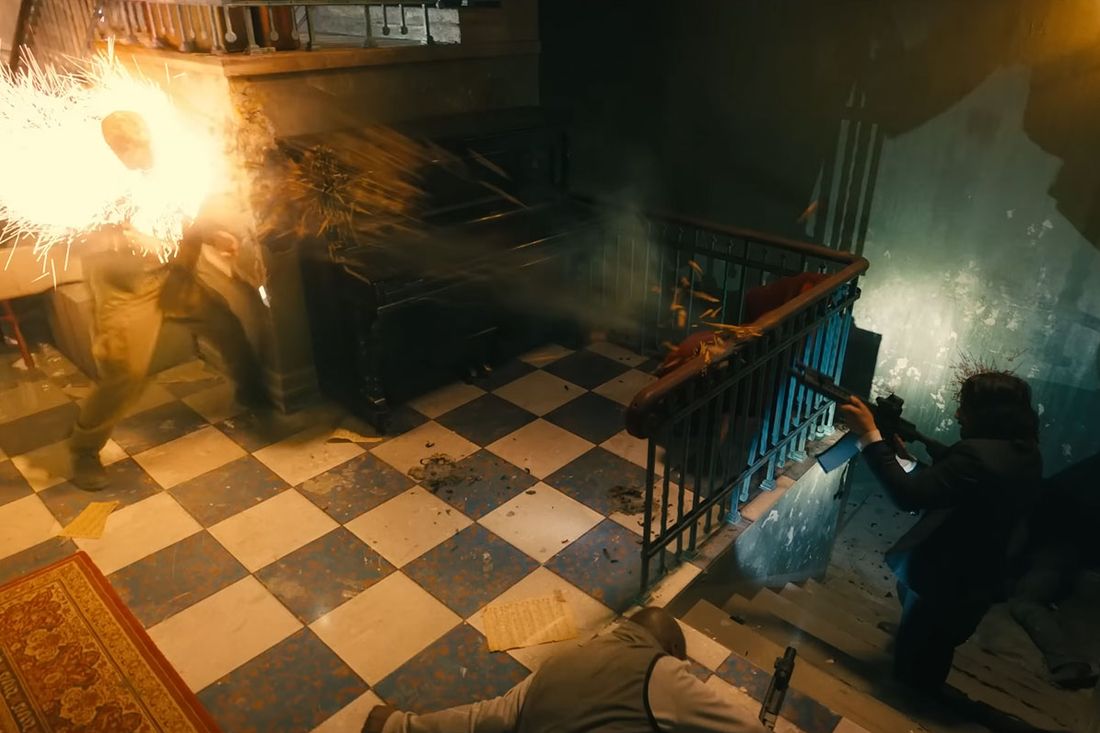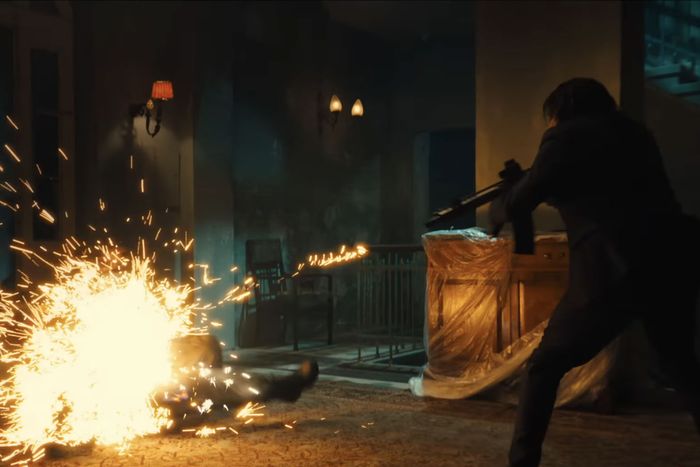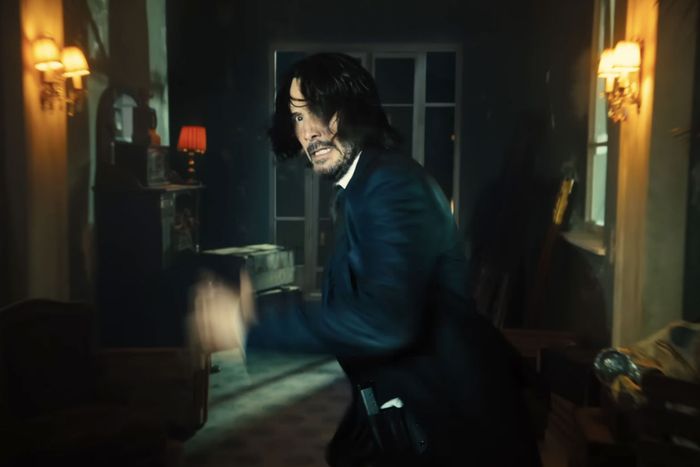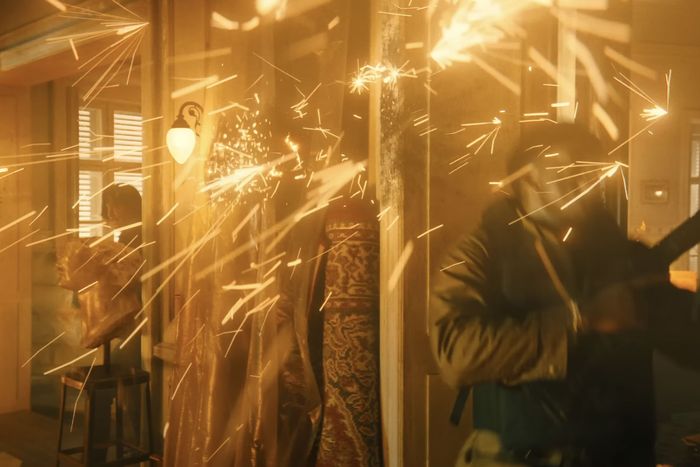
Over three ultraviolent, neon-lit, mythologically elaborate films, weÔÇÖve seen Keanu ReevesÔÇÖs reluctant assassin John Wick do it all. How to (maybe) wrap the franchise with a final installment that gives audiences something new? A trio of white-knuckle action sequences in John Wick: Chapter 4ÔÇÖs final hour seemed like the answer. All are set in Paris ÔÇö the first one in the traffic circle around the Arc de Triomphe, the last hurling Wick down the 222 stairs leading to the Sacr├®-C┼ôur Basilica. But the sequence in the middle, an apartment-set shoot-out, posed a problem.
ÔÇ£The staircase I knew I could own because it was a metaphor for Sisyphus rolling the boulder up the hill and being knocked down. We had that dialed in; we had the Arc de Triomphe dialed in,ÔÇØ director Chad Stahelski says. ÔÇ£The apartment fight wasnÔÇÖt clicking. It was just a fight in an apartment. And IÔÇÖm like, How do we shift perspective?ÔÇØ The former stuntman, who has helmed every John Wick installment, found the ÔÇ£special sauceÔÇØ of inspiration in the 2019 video game Hong Kong Massacre, which unfolds from a birdÔÇÖs-eye view. ÔÇ£There was a visual there that shouldnÔÇÖt have made sense but did,ÔÇØ he says. ÔÇ£It was part video game, part anime, part cinematic experience.ÔÇØ
Stahelski and the crew turned this shoot-out into one of the most visually arresting segments of the entire John Wick franchise. The cameraÔÇÖs smooth movement, the explosive bursts of light from the DragonÔÇÖs Breath ammunition, the choreography required to nail the one-take shot ÔÇö it all combines into what cinematographer Dan Laustsen calls ÔÇ£a really good gag.ÔÇØ
ÔÇ£You want it to feel naturalÔÇØ
Stahelski shared clips from Hong Kong Massacre with the crew, and together they began brainstorming how to apply its camera approach to Chapter 4. Two components were key to making the sequence work: the top-down perspective that lets viewers see the foes before Wick does and the flammable destruction of the DragonÔÇÖs Breath rounds, which provide a dazzling layer of tension and chaos.
A crucial detail of production designer Kevin KavanaughÔÇÖs plan for the seven-room apartment set (built at Studio Babelsberg in Potsdam, Germany) was its height ÔÇö the walls had to be tall enough for the camera to track Wick up a stairwell into the first room and then continue floating and settling above him.
ÔÇ£You want it to feel natural so youÔÇÖre not all of a sudden just in this weird top shot,ÔÇØ stunt coordinator Scott Rogers says. ÔÇ£That really became our biggest challenge: the lack of height.ÔÇØ The production team worked for a month to build a space with 12-to-14-foot walls, though ÔÇ£if we had a ceiling that was 20 feet higher,ÔÇØ Rogers adds, ÔÇ£everything would have been easier.ÔÇØ
Meanwhile, as French stunt coordinator Laurent Demianoff choreographed the sceneÔÇÖs hand-to-hand and firearms action, Stahelski, Laustsen, and Rogers ran through ÔÇ£probably a dozen different conceptsÔÇØ of how to get the shot in one (seemingly) uninterrupted take. (ÔÇ£ThereÔÇÖs only one seam in there, and thatÔÇÖs before we light the guys on fire in the kitchen,ÔÇØ Stahelski explains. ÔÇ£The rest is all one take.ÔÇØ)
All that prep came up against a tight deadline. ÔÇ£The set was literally built and finished on a Sunday night, and we started shooting Monday,ÔÇØ Stahelski remembers.
To film the scene, the crew used a Spidercam system designed and operated by Laustsen and his team. Often employed to film professional sports, the Spidercam is suspended between four wires attached to different corners of the set and is remotely controlled by an operator with a joystick. It can tilt and pan at the same time, allowing it to move down closer to the actors as necessary ÔÇö and when Wick steps into the apartmentÔÇÖs entryway, the action properly begins.
ÔÇ£Okay, that means I canÔÇÖt mess upÔÇØ
John Wick: Chapter 4 is the longest film of the franchise, and maintaining fluid pacing is one of its foremost priorities. ÔÇ£If John Wick does nothing else exceptionally well, thereÔÇÖs a rhythm to it,ÔÇØ says Rogers. ÔÇ£ItÔÇÖs a dance, and thereÔÇÖs a rhythm to the dance, and it builds and builds, and it comes down, and then it builds.ÔÇØ
At the center of that dance is Reeves, who continues to perform the majority of his own stunts in Chapter 4 ÔÇö even for the apartment scene, which almost exclusively features the top of his head. ÔÇ£We could have done it without him; you never see his face until the camera comes down,ÔÇØ Rogers says. ÔÇ£But he was like, ÔÇÿNo, I want to do it. I want to do this.ÔÇÖÔÇØ
Stahelski remembers explaining his idea for a one-take shot to Reeves. ÔÇ£Okay, that means I canÔÇÖt mess up,ÔÇØ he recalls the actor saying. ÔÇ£He just looks at me and goes, ÔÇÿCool, I got to go to the gym. I better practice more.ÔÇÖÔÇØ
Demianoff spent three weeks on the sceneÔÇÖs choreography, while the stunt team put together a proof of concept that Laustsen used to coordinate the lighting and the SpidercamÔÇÖs exact route through the apartment. The stunt actors playing WickÔÇÖs enemies were tasked with executing complicated choreography with painstaking precision. ÔÇ£Every time one person messes up, youÔÇÖre back to the beginning, and it wasnÔÇÖt an easy reset,ÔÇØ Stahelski says.
To capture every detail of the shoot-out ÔÇö every Wick reload, DragonÔÇÖs Breath ember, and TrackerÔÇÖs dog racing across the furniture ÔÇö as vividly as possible, Laustsen changed the cameras and lenses to ÔÇ£bigger format, bigger sensorÔÇØ options from those he had used in the second and third John Wick films.
ÔÇ£ItÔÇÖs shot much wider and tighter. We took all the middle sizes out,ÔÇØ Laustsen says. ÔÇ£We were thinking a lot about Once Upon a Time in the West,ÔÇØ the Sergio Leone spaghetti western famous for its sweeping shots of UtahÔÇÖs Monument Valley and its close-ups of stars Charles Bronson and Henry Fonda.
Finally, late in the German production schedule, it was time to go from rehearsal to reality. It was bumpy at first. ÔÇ£The camera guys have rehearsed, the stunt guys have kind of rehearsed, KeanuÔÇÖs kind of rehearsed, but weÔÇÖve never done it all together,ÔÇØ Stahelski says. ÔÇ£So the first day was by far the roughest. But then you kind of get your rhythm and everybody comes in sync.ÔÇØ
ÔÇ£How beautiful can I make it?ÔÇØ
When the scene begins, the space is so bluish black that Wick and his assailants look almost like silhouettes ÔÇö until the first DragonÔÇÖs Breath round explodes. The searing light from the shotguns is entrancing and creates new shadows and distractions.
The set was lit by a mixture of tungsten, LED, and neon lights placed outside the apartment (ÔÇ£Each room had to have a different character,ÔÇØ Laustsen says), while the explosions created by the DragonÔÇÖs Breath rounds were created digitally. Stahelski held on to the idea of using the flammable ammo specifically for the top-down shot to add life to a scene that would otherwise be spent ÔÇ£looking at the same color floor.ÔÇØ
Without the DragonÔÇÖs Breath, ÔÇ£the shot would be a lot more boring. It wouldnÔÇÖt last half as long,ÔÇØ explains Rogers. (Stahelski recalls LaustsenÔÇÖs similar reaction to the top-down idea: ÔÇ£What are you, crazy? ThatÔÇÖs going to bore the crap out of people.ÔÇØ)
Stahelski asked himself, ÔÇ£How many different colors can I put in this scene? How beautiful can I make it?ÔÇØ The eureka moment: ÔÇ£Screw it. IÔÇÖm just going to light people on fire.ÔÇØ
The crew couldnÔÇÖt use actual DragonÔÇÖs Breath rounds, so Laustsen and his team used a flame gun to create a lighting reference for the visual-effects department, which later added the sparks and flares. Visual effects also helped maintain continuity when WickÔÇÖs assailants catch fire in the apartmentÔÇÖs kitchen (done practically by the stunt team) and when the scene briefly cuts to some ground action of Wick fending off attackers.
But the rest of the scene was shot as a oner. Stunt coordinator Steve Dunlevy kept the beat, counting from 1 to 60 on a microphone so everyone could hit their marks at the right time, from the staircase opening and initial camera drift, through the kitchen fire ÔÇö which took more than 30 takes, Stahelski says ÔÇö and ending with Wick and the Tracker chasing each other through the apartment before the former jumps out a window. ÔÇ£We shot the whole thing in less than three days,ÔÇØ Stahelski says.
At the wrap, the cast and crew knew they had something special ÔÇö an ÔÇ£entertainingÔÇØ and ÔÇ£ludicrousÔÇØ effort, as Rogers puts it, that captures what makes a John Wick movie a John Wick movie. But in the editing room, Stahelski found himself fighting to keep the sequence in. HeÔÇÖs glad he won.
ÔÇ£When you see the top shot without all the cool effects and you donÔÇÖt see any of the DragonÔÇÖs Breath coming out with the muzzle flashes, what do you think is on the cutting table? Until pretty much the end, that was on the list that a lot of other people thought we should cut,ÔÇØ Stahelski says. ÔÇ£It wasnÔÇÖt until we put in the temp visual effects that people go, ÔÇÿOh, fuck. We didnÔÇÖt think it was going to be anything like that.ÔÇÖ And IÔÇÖm like, ÔÇÿGood thing we didnÔÇÖt cut it.ÔÇÖÔÇØ
Additional reporting by Vulture senior reporter Chris Lee. 
More From This Series
- And the Winners of the 2024 Stunt Awards Are 
- The Second Annual Stunt Awards Are Here
- The Best Movies of 2023





